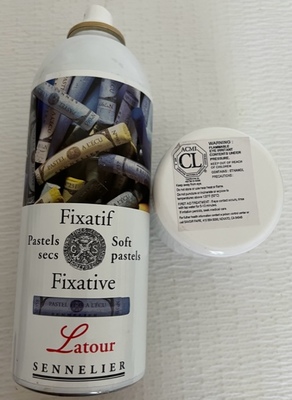Sale on canvas prints! Use code ABCXYZ at checkout for a special discount!

A big debate for soft pastel artists, do you use fixative? Let’s explore this subject.
What? Fixative is used to help bind the pastel to the paper. This fixative is sprayed over the pastel on the paper. Remember to use fixatives sparingly and with proper ventilation – think about going outside and spraying when there is no wind. Do not overspray. Soft pastel can run off the paper if it gets wet. Fixatives can dull your picture down by changing colors or dissolving layers when applied. Improper sprays can create unfortunate dots or blobs on the artwork.
When? Fixative can be applied after you put down a drawing to not lose the original design through applications of pastel. This may be a good idea if you have a really detailed drawing. Some artists spray after underpainting. I may use a fixative in areas that need more details and either the tooth of the paper is too full, or 2) if the types of pastel won’t stick to each other, or to the paper anymore (aka between layers). I also lightly spray anything that I ship without a frame. It’s a gamble either way. Pastel particles will shed and smudge with or without fixative.
Type? There are all kinds of price ranges for pastel fixatives. I prefer Sennelier for pastel artwork and have also used less expensive working fixatives by another brand. Expect the colors to slightly change. You may need to reapply some part of the pastel to the painting. Remember to let the painting dry before touching up. And please do not use hairspray as a fixative. You spent good money on soft pastel sticks and sanded papers. Spend money on a proper soft pastel fixative. If you glaze pastel artwork with acrylic, that’s a different story not addressed here.
Secrets. I came across secrets from well-known artists that claim you can do “this” instead of using a fixatives. Let’s review.
1) Use a rolling pin to crush the pastel into the paper. Ok, this really pushes pastel into the grid of the paper. Do not go over with a roller pin more than a couple times or you will lose detail strokes and blur the painting. Think of the time lost having to redo your painting. However, this may be something to consider at the beginning of a painting.
2) Put the painting in the sun “to bake” for 30 minutes. I don’t know if this really works. The theory is it is really hot outside, it bakes into the paper. My experiment almost melted because even though it was hot, it was also humid. I pulled the painting inside just as the whites were getting gooey and it took two days to completely dry. I was also afraid of nature (wind and insects) disturbing the painting. Maybe consider this option if you are in a hot, dry, bug-free climate.
You can frame your masterpiece with or without fixative. Soft pastel will shed onto the mat or glass either way. Consider how your gallery views loose pastel on glass or mat frames. In the end, the viewing public may never know if your soft pastel painting was sprayed with a pastel fixative when applied correctly. Using fixative is a personal choice to make.